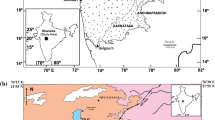Abstract
Exploration for diamond-bearing kimberlites in the Chidliak project area by Peregrine Diamonds has generated a grid-like till sampling pattern across four discrete areas of interest totalling 402 km2 that is densely populated with research-grade compositional data for 10,743 mantle-derived Cr-pyrope garnets. The available dataset is well suited to statistical analysis, in part due to the relatively unbiased spatial coverage. Previous workers showed empirically that the TiO2 and Mn thermometry (Ti-TMn) attributes of Cr-pyrope populations at the Chidliak project may serve as source-specific “fingerprints”. In this work, we employ a simplified version of the multivariate Mahalanobis distance technique to formally examine the variability of, and differences between, Ti-TMn attributes of Cr-pyrope subpopulations recovered from a Laurentide-age glaciated terrain that also contains 30 known kimberlites within the four areas of interest. We show the simplified Mahalanobis distance approach enables accurate discrimination of Cr-pyrope subpopulations with subtly to distinctly different Ti-TMn attributes, and permits proper demarcation of their respective kimberlite source(s), specifically in areas with straightforward glacial histories. Redistribution and blending of Cr-pyrope subpopulations from known kimberlite sources is also observed, and typifies areas at Chidliak with complex late-glacial histories. Our results support <1 km horizontal scale subtle to obvious variability in the proportions of TiO2-rich and high-temperature (> 1100 °C) Cr-pyropes between closely spaced kimberlite source(s) and also between physically adjacent magma batches within single kimberlite pipes. The local scale variability is attributed to protokimberlite fluid or melt interacting with, and metasomatizing discrete conduits within, the ambient diamond-facies peridotitic mantle at times closely preceding eruption of kimberlite magma batches at Chidliak.







Similar content being viewed by others
References
Averill SA, Huneault RG (2003) Controlling the quality of kimberlite indicator mineral processing using indicator mineral spikes. The Association of Applied Geochemists, Explore. Newsletter 119:19–21
Averill SA, McClenaghan MB (1994) Distribution and character of kimberlite indicator mineral in glacial sediments, C14 and Diamond Lake kimberlite pipes, Kirkland Lake, Ontario. Geol Surv Canada Open File 2819, 52 p
Broster B, Munn M, Pronk A (1997) Inferences on glacial flow from till clast dispersal, Waterford area, New Brunswick. Géog Phys Quatern 51:29–39
Clark R (1967) A contribution to glacial studies of the Malham Tarn area. Field Stud 2:479–491
Clayton KM (1966) The origin of the landforms of the Malham area. Field Stud 2:359–384
Creighton S (2009) A semi-empirical manganese-in-garnet single crystal thermometer. Lithos 112S:177–182
Giuliani A, Kamenetsky VS, Kendrick MA, Phillips D, Wyatt BA, Maas R (2013) Oxide, sulphide and carbonate minerals in a mantle polymict breccia: Metasomatism by proto-kimberlite magmas, and relationship to the kimberlite megacrystic suite. Chem Geol 353:4–18
Grütter HS, Tuer J (2009) Constraints on deep mantle tenor of Sarfartoq-area kimberlites (Greenland) based on modern thermobarometry of mantle-derived xenocrysts. Lithos 112S:124–129
Grütter HS, Apter DB, Kong J (1999) Crust–mantle coupling: evidence from mantle-derived xenocrystic garnets. In: Gurney JJ et al (eds) Proceedings of the 7th International Kimberlite Conference, vol 1. Red Roof Design, Cape Town, pp 307–313
Grütter HS, Gurney JJ, Menzies AH, Winter F (2004) An updated classification scheme for mantle-derived garnet, for use by diamond explorers. Lithos 77:841–857
Januszczak N, Seller MH, Kurszlaukis S, Murphy C, Delgaty J, Tappe S, Ali K, Zhu J, Ellemers P (2013) A multidisciplinary approach to the Attawapiskat kimberlite field, Canada: accelerating the discovery-to-production pipeline. In: Pearson D et al (eds) Proceedings of 10th International Kimberlite Conference, vol 2. Springer, New Delhi, pp 157–171
Johnson C (2014) Fingerprinting Quaternary subglacial processes on Hall Peninsula, Baffin Island, using multiproxy data. Masters thesis, University of Waterloo, Canada
Johnson C, Ross M, Tremblay T (2013) Glacial geomorphology of north-central Hall Peninsula, southern Baffin Island, Nunavut. Geol Surv Canada Open File 7413, 57 pp
Malkovets VG, Griffin WL, O'Reilly SY, Wood BJ (2007) Diamond, subcalcic garnet and mantle metasomatism: kimberlite sampling patterns define the link. Geology 35:339–342
Neilson S, Grütter H, Pell J, Grenon H (2012) The evolution of kimberlite indicator mineral interpretation on the Chidliak project, Baffin Island, Nunavut. Tenth International Kimberlite Conference Extended Abstract #162, 5 pp
Pell J, Grütter H, Neilson S, Lockhart G, Dempsey S, Grenon H (2013) Exploration and discovery of the Chidliak kimberlite province, Baffin Island, Nunavut: Canada’s newest diamond district. In: Pearson D et al. (eds) Proceedings of 10th International Kimberlite Conference, vol 2, Springer, New Delhi, pp 209–227
Teknomo, K (2014) Similarity Measurement. http://people.revoledu.com/kardi/tutorial/Similarity/MahalanobisDistance.html. Accessed on May 30, 2014
Acknowledgements
The authors acknowledge support and encouragement provided by Peregrine Diamonds Limited, and the permission granted to publish these results. Overburden Drilling Management Limited and C.F. Mineral Research Limited are thanked for providing the year-on-year consistent, research-grade indicator mineral data that underpin our work. We are grateful to the Editor-in-Chief of the journal for meticulous editing, rapid turn-around and constructive comments to improve overall presentation. Two anonymous peers also provided brief comments.
Author information
Authors and Affiliations
Corresponding author
Additional information
Editorial handling: L. Nasdala
Electronic supplementary material
ESM 1
(PDF 3529 kb)
Rights and permissions
About this article
Cite this article
Grütter, H.S., Pell, J.A. & Fitzgerald, C.E. Use of a simplified Mahalanobis distance approach to constrain the dispersion and provenance of Cr-pyrope populations at the Chidliak kimberlite province, Nunavut, Canada. Miner Petrol 112 (Suppl 2), 707–718 (2018). https://doi.org/10.1007/s00710-018-0578-7
Received:
Accepted:
Published:
Issue Date:
DOI: https://doi.org/10.1007/s00710-018-0578-7




